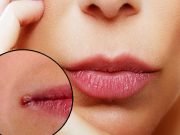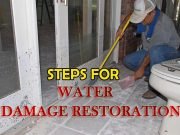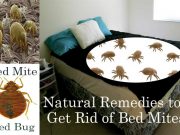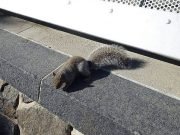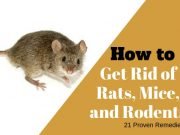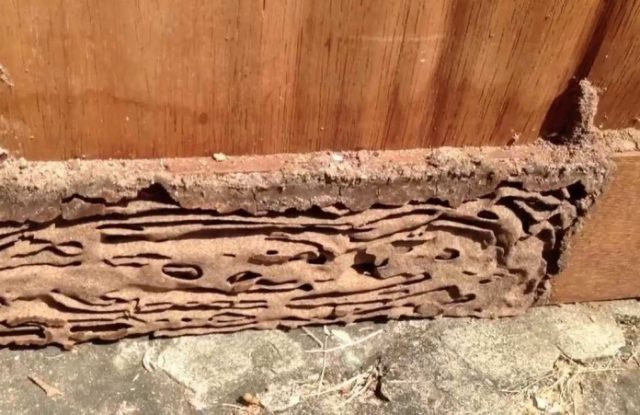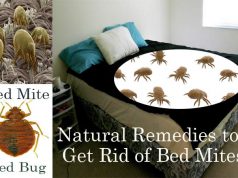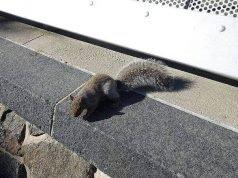So you have termites, and you are out of your mind. Not only would they eat away through all the expensive furniture items in their own sweet time, people have actually found their roofs collapsing on their heads thanks to these silent little devils. Read on to know about the different types of termites, the reasons why they infest your living spaces, and most importantly, how to eradicate these creeps.
Types of termites
1. Subterranean termites
These termites that live in soil and build some of the largest, longest and most complicated nests. They gain access to our houses via trees and timber fittings. These species are the most destructive because they work at a very fast pace over large areas. They are so common that you are likely to meet them at some point in your life.
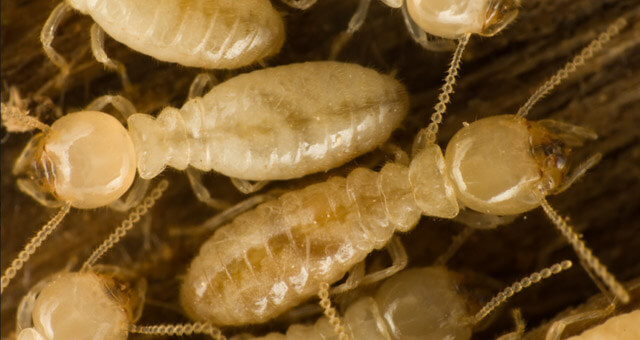
How to identify them?
These are creamy white to dark brown or black in color. Also, these termites are long, narrow and oval in shape. Around 1/8 inch in length, these are found throughout the USA.
2. Drywood termites
These termite species belong to the Kalotermitidae family. They can cause extensive damage to your house because they typically nest in hardwood floors and timber fittings. They do not need soil to sustain them. They act very slowly, and once your home is attacked by them, you need to be on the lookout forever for repeated infections.
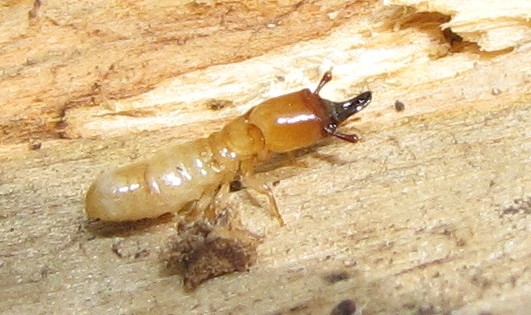
How to identify them?
Creamy white to light brown in color. Long, narrow and oval in shape. 3/8 to 1 inch in length. These termites are primarily found in the coastal regions from South Carolina westward to Texas up to the west coast of California.
3. Dampwood termites
The dampwood termites belong to the families Hodotermitidae and Kalotermitidae and the species are mostly found in woods with large moisture content. They are less destructive and likely to cause you less trouble as they are seldom found in homes. This is because the wood used in homes are very dry and does not support them.
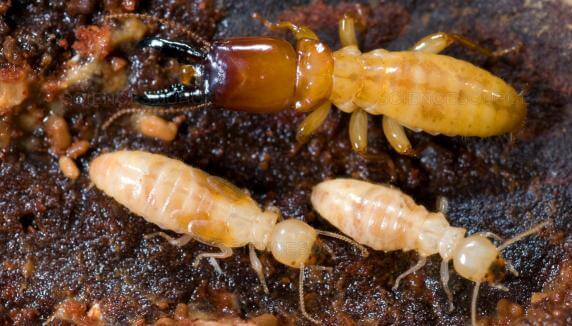
How to identify them?
These creatures are creamy white to brownish in color, and long, narrow and oval in shape. These measure half an inch to 5/8 inch long. In the US, these are found throughout the Pacific coast and the states adjacent to it, in the desert or the semi-arid southwest, and southern Florida.
Signs Of Termite Attack
Termites stay away from light, especially natural light. So it often becomes hard to get to know of their existence before the damage is substantial. You can always start by being on the lookout by checking your wood, your grass, your garden, your basement and the outside of your house.
Damage To Wood
This is of utmost concern for those who have wooden houses. And well, most of the people in the US have them. Did you just get goosebumps? You might as well.
It is very important that you check your wooden fittings, your flooring and all your wood furniture at least once a week for any possible damage. The surface below your flooring is the first place likely to be affected by subterranean termites, the most damaging of all. When you have old wood, you need to be doubly careful, as the softened cellulose is doubly attractive for termites. You can always ask for help from experts.
Wings
Termites come with cretinous wings, which they shed. So if you find some discarded ones lying near the windows, doors or other entry points to your home, get ready for battle, as your living space has been invaded by flying termites. The moment they come across a nice cosy spot for them to start digging, they twist off their wings and shed them before entering their tunnels, as they won’t need them again.
You may think that there is a chance for confusion between wings belonging to ants and termites. Well, unlike ants, termite wings come in the same size. So, you know what to look for at every corner of your house.
Mud tubes
These are the telltale signs of termite infestation. Mud tubes are mostly made by subterranean termites. The worst thing is these can be found even in concrete apartments. That’s because subterranean termites are more than happy to make their way through concrete in their bid to reach wood or to chew down the wooden foundations. Mud tubes can also be found near trees, on walls, sheds or the connecting point between the ground and your house.
While these structures are typical of termites, you may be doubly sure by removing a section of the tube and seeing the beasts. However, many nests are abandoned, and these termites are very fast at rebuilding.
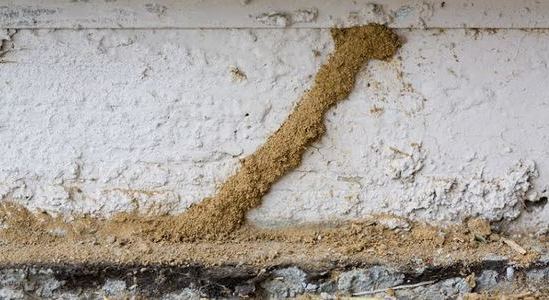
Brown poo pellets
Termite droppings are in the form of pellets- dark brown or wooden in color, and may be found near weakened or old wood. Inspect them using a flashlight for the best results.
In fact, a good way to check the quality of the woodwork at your place is using a flashlight and a screwdriver. Unless the wood is already eaten from inside, it is supposed to be solid. Test for the strength by pushing it with your screwdriver. If it caves in, understand that there is a termite problem.
What Causes Termites In The House?
- A lot of moisture
- Lack of air and sunlight
- Accumulated dirt and wooden mulch
- You are simply unlucky
- Infestations nearby
Here are some ways to eliminate termites at home, without using chemicals:
Orange oil
This is the oil extracted from orange peels. It is not water soluble. And though the fragrance is fruity, you need to be very careful while handling it as it is not safe for humans. It may cause stomach problems if you ingest it. It is also likely to cause irritation in eyes, skin, and nose. It can be used to kill drywood termites particularly quickly.
Orange oil is actually very effective in killing a large number of insects as it destroys their cell membranes. The active ingredient d-limonene is particularly effective against termites. All you need to do is to drill a small hole in the infested wood and pour the oil in. You will get the results anytime between 3 days to 3 weeks. The actual duration, of course, depends on severity of the infestation. In laboratory experiments, it has shown a high rate of effectiveness, with termites showing 68-96% mortality.
Flooding the soil
This is one of the easiest ways to get rid of termites over a large area. However, this won’t be a long-term solution while dealing with subterranean termites who are not easily daunted.
All you need to do is to drown the termites. If you see the mud tubes in your garden, just dig through the area and then flood it. You will get rid of them in no time. If it is some area inside your house, you can try flooding them using a hose.
Boric acid
This is a natural and very potent insecticide that works by damaging the nervous systems of all kinds of termites and thus eventually kills them. All you need to do is to mix some boric acid powder with some water and apply upon to the affected wooden surface with the help of a paintbrush.
Spraying or painting wooden furniture or fittings with Borax is a good idea too as it would dry up to leave behind crystallized boric acid. The termites would be ingesting this when they attack the wood.
Borax also dehydrates termites. Prepare a solution by dissolving one teaspoon of borax powder on an 8-ounce cup of hot water. Applying them on wood from time to time ensures continued protection.
Aloe vera gel
In addition to being awesome in treating a number of health problems and being part of quite a few beauty regimens, aloe vera is also very effective against termites. A very common household plant, aloe vera provides you one of the easiest methods of getting rid of termites. Crush some aloe vera leaves. Put them in a cup of water. Now apply this mixture on an infested area. On coming in contact with this liquid, the termites will instantly die.
Cardboard traps
You can make your very own cardboard traps for these pesky beasts. Prepare some flat strips of soft but enduring cardboard. Wet them and arrange them in places infested by termites so that they have ample space to walk over them. Soon you will see the termites flocking over. This is because the cardboard is made of termites’ favorite food ingredient- cellulose. Once you see the boards are full, take them out slowly one by one and burn them along with the termites. You need to do this multiple times.
However, keep in mind that this would work only as a quick fix for small termite infestations. Remember to handle the boards with gloves and not to carry them over other items having cellulose, like stacks of important papers. Try to have your bonfire as near the cardboard traps as possible.
White vinegar
White vinegar is an easily available kitchen ingredient that you can use to do away with a lot of insects like ants and termites. This, however, like cardboard traps, is effective against only minor infestations in small areas.
To use this effectively against termites, mix half a cup of white vinegar with the juice from 2 lemons. Now pour this into a spray bottle and spray it on any area where you see termites. Repeat this process twice daily for a number of days.
Using salts
You can use both sodium chloride and granulated salt for this purpose.
Sodium chloride or the common salt is among the easiest and the cheapest ways to get rid of termites. Just fill a jar with equal parts of common salt and warm water. Now using a syringe, sprinkle the salt water over all the affected areas. You can also simply sprinkle some salt on the furniture. The termites will die in massive numbers due to dehydration.
You can also use granulated salt for this purpose as it is stronger and more potent than the common salt. All you need to do is to sprinkle some salt over the areas affected by the termites. Not only will the termites be killed, but you will also be saved from termite attacks in the near future.
Diatomaceous earth
Diatomaceous earth, thanks to super-sharp edges of the particles, is excellent at killing a number of insects including soft-bodied termites. They abrade the outer shells of the insects, causing them to lose all their bodily moisture and die. Diatomaceous earth is good for killing both subterranean as well as drywood termites.
To use this, sprinkle a thin layer of it on the infested areas. Repeat once every day as long as there are termites remaining. And, to avoid infestation altogether spread some garden-grade diatomaceous earth along the foundation of your home once in a while, and in areas where there may be future infestations.
Take care to wear a mask, goggles and a pair of gloves while handling diatomaceous earth. You don’t want the sharp bits to get embedded on your skin and cause considerable irritation.
Essential oils
Essential oils are very effective at getting rid of termites. For example, both clove bud oil and vetiver oil not only kill termites but also keep them away. Just put some essential oil in a mist sprayer and copiously spray it over the affected places. Essential oils work at the surface level itself.
Essences of garlic have been found to be effective against termites. Prepare a highly concentrated solution of garlic using hot or cold water. It would result in 100% mortality for the termites.
Another oil found effective in termite treatment is canola oil. You can spray this directly, or you can prepare a solution.
Nematodes
While this is not exactly DIY, this is one of the most efficient natural methods to control termites. A large number of commercial products available in the market containing worms parasitic to termites, known as nematodes. They are available as cruisers and ambushers.
The cruisers like Heterorhabditis bacteriophora and S. glaseri go looking for the insects, whereas the ambushers such asSteinernema carpocapsae and S. scapterisici lie in wait for them. All you need to do is to sprinkle the market products and thus release the minuscule worms. They enter the system of the insects through openings like respiratory spiracles. Once inside, they unleash bacteria which can then liquefy the insides of these termites. Once the host is consumed, the nematodes split up and go for other insects.
In addition to all these, you can take some simple precautions as a part of your daily routine to keep termite infestation in check. Measures like allowing plenty of air and sunlight to enter your rooms, regularly dusting and checking furniture and other wood like kitchen cabinets and fittings, removing accumulated waste, controlling the moisture content of your residence and the adjacent areas, and polishing furniture and wooden frames is a good way of prolonging your wooden health against termites.
You may know also –








